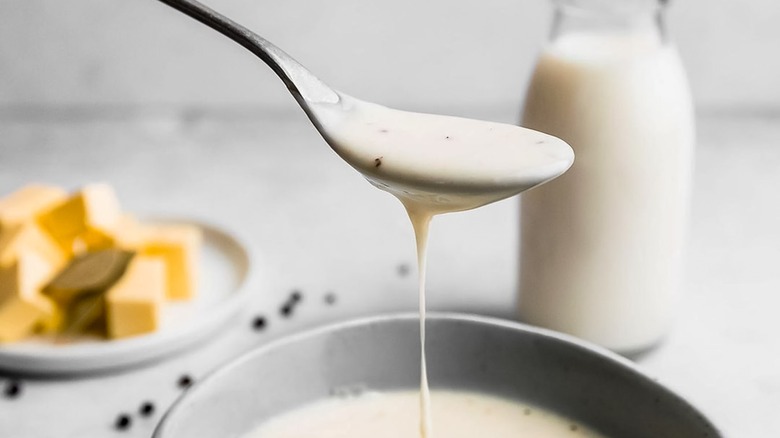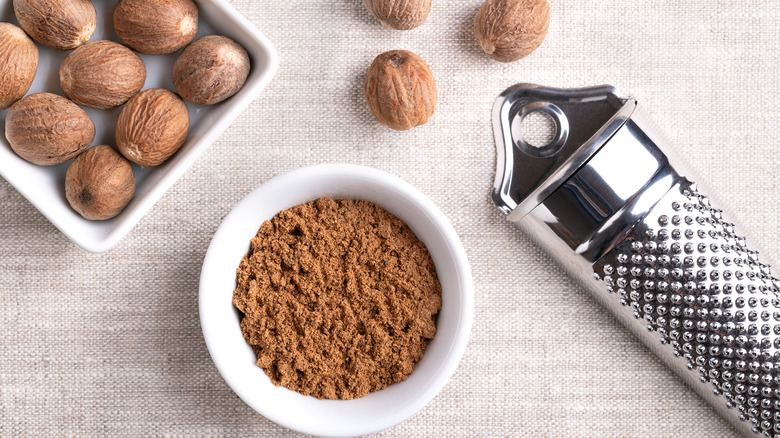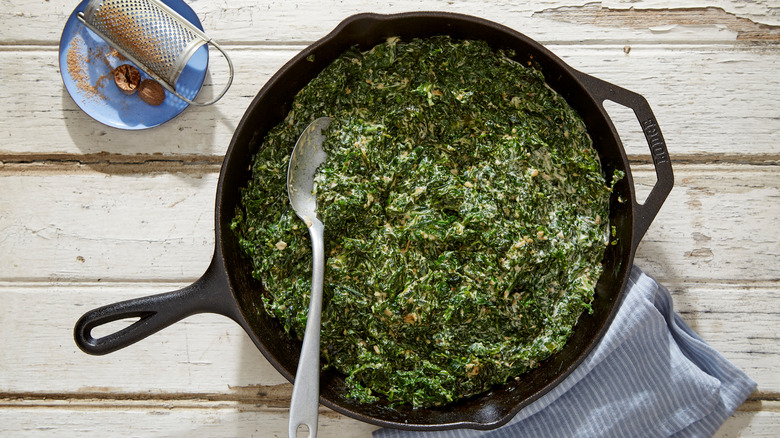This One Ingredient Takes Your Cream Sauces To The Next Level
Cream sauces add a comforting richness to so many dishes, wrapping all the ingredients together like a velvety soft blanket. But if you feel like the creamy component sometimes lacks flavor when you make it at home, then there's one often-overlooked ingredient that can deliver almost restaurant-worthy results every time: nutmeg.
Nutmeg is the seed of the Myristica fragrans tree (yes, it's a seed, not a nut, despite the name). You might associate the flavor more with seasonal treats like pumpkin pie or eggnog, but it also brings that familiar warmth and subtly sweet spice to everyday savory dishes as well as desserts. This versatility and adaptability make it one of the secret ingredients you should be adding to spaghetti sauce, and the spice goes especially well in creamier variations.
While it's sometimes marked as an optional ingredient in recipes, nutmeg is actually a key seasoning in many white sauces. It can enhance a basic béchamel, and bring extra depth to any rich cream sauce to serve with pasta, chicken, fish, or vegetables. You only need a pinch, but the impact is well worth it, as it adds an earthy complexity that stops the finished result from tasting flat, bland, or just a bit one-note
How to use nutmeg for the best creamy sauces
Nutmeg is commonly found as a ready-ground powder, but you can also buy whole seeds and grate it yourself using a microplane or nutmeg grater. Freshly grated will bring the best results in terms of flavor, and when stored whole, it has a long shelf life of months or even years. Ready-ground is convenient and time-saving, though it will not last long once opened before it starts to lose aroma and flavor. If you're only using it occasionally, you may find that buying it whole is a better option.
As for when's the best time to add nutmeg to sauces such as béchamel, there are a couple of options. To experience the flavor at its fullest, add a pinch of ground nutmeg at the end of the process as a seasoning once the hot sauce is cooked. For a subtler impact, add the nutmeg as you whisk the milk into your roux (a paste made from butter and flour). Cook the creamy mixture for around 15 minutes, so the gentle flavor can infuse. You don't need much of the spice; if you're using a quart of milk, a quarter of a teaspoon of nutmeg is ample.
To create a richer cream sauce, simply add heavy cream and white wine to a basic béchamel sauce, and dust it with nutmeg. The spice also works well in other creamy sauces such as with homemade fettuccine alfredo.
The spice can elevate other savory dishes, too
Nutmeg has many culinary uses beyond cream sauces. Along with lemon zest, it's an ingredient that Queen Elizabeth sprinkled on her scrambled eggs to give them an elegant flavor boost. For another delicious brunch dish, top ramekins of eggs, heavy cream, and spinach with a dusting of nutmeg before baking in the oven until just set. The delicate heat of nutmeg also works beautifully in light fluffy soufflés.
Starchy foods respond especially well to this spice, particularly if there's a creamy dairy element to them — it's one of the reasons it works so well in rich pasta dishes. Try adding a little grated nutmeg to buttery mashed potatoes enriched with milk or heavy cream; simply add a sprinkle to milk and melted butter as it heats through in a pan, and then stir it into the mash for a luxurious finish.
A pinch of nutmeg also complements other dairy-enhanced vegetable dishes. Try it with buttery green beans or creamed spinach, or sprinkle it onto cheesy cauliflower. Mix a little of the spice with butter and brown sugar to elevate sweet potatoes, pumpkin, or baked squash dishes for a savory yet sweet and lightly spiced side dish. Alternatively, you can mix it into a savory spice blend to rub onto meat or add it to hearty and flavorful soups and stews.



